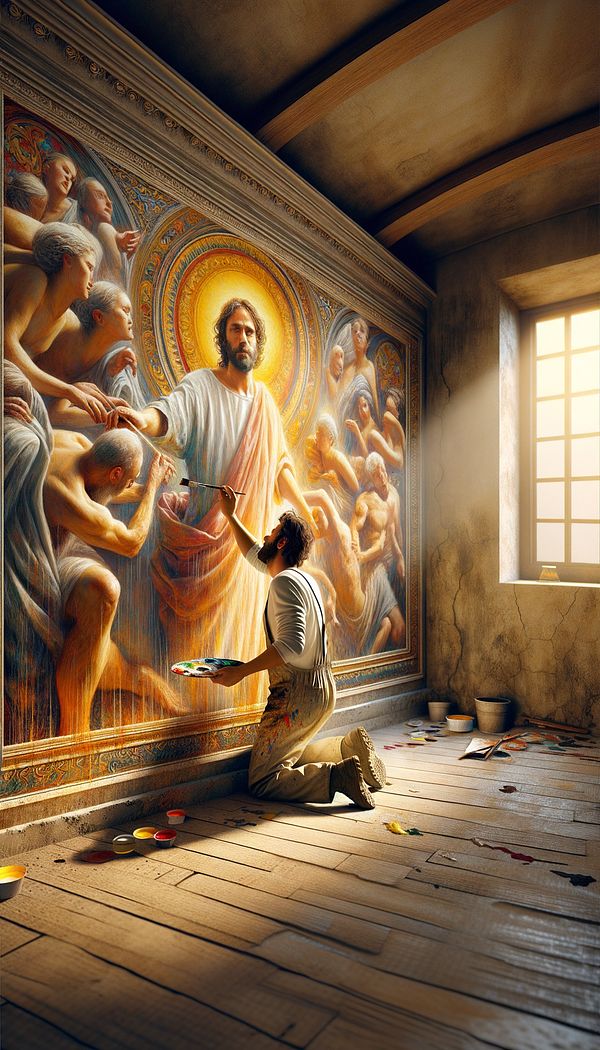What is a Fresco?
Fresco is a technique of mural painting executed upon freshly laid wet plaster.
Description
A fresco is one of the oldest and most distinguished forms of mural art, where pigments are applied directly onto wet plaster. This allows the colors to merge with the plaster as it dries, creating a beauty and durability that can last for centuries. The term "fresco" comes from the Italian word for fresh, reflecting the need for the plaster to be fresh and moist for the pigments to be absorbed effectively.
The process of creating a fresco involves several meticulous steps. Firstly, a rough plaster layer, called the "arriccio," is laid to prepare the wall. Sketches, or "sinopie," are often drawn on this layer to guide the artist. A final, thin layer of fine plaster, known as the "intonaco," is then applied upon which the painting is done while the plaster is still wet. Because the pigment bonds with the plaster as it dries, fresco paintings have remarkable longevity and resistance to fading.
Frescos offer a rich vibrancy of colors and a unique texture that cannot be replicated by other painting techniques. They have been used throughout history to decorate the walls and ceilings of buildings, from ancient temples to Renaissance churches, reflecting a broad spectrum of themes, from religious to mythological and everyday scenes.
Despite the durability of fresco paintings, they require skillful hands and meticulous planning to execute, given the challenges of working with wet plaster and the need for rapid application of pigments before the plaster dries. The result, however, is a breathtaking piece of art that becomes an integral part of the architecture itself.
Usage
Fresco has been prominently used throughout history, especially during the Renaissance period, to adorn the walls and ceilings of prominent buildings such as churches, cathedrals, and public spaces. Today, fresco painting is celebrated in the restoration of historic buildings as well as in contemporary architecture, where it adds a timeless beauty and a sense of grandeur to interior spaces.
FAQs
-
Can fresco paintings be done on any surface?
Fresco paintings are typically executed on plaster walls or ceilings. The surface needs to be freshly laid, wet plaster to ensure the pigments bond properly with the surface as it dries.
-
How long do fresco paintings last?
When properly executed and maintained, fresco paintings can last for centuries. Their durability is a result of the pigment merging with the plaster, which protects the artwork from fading and environmental damage.
-
Are there different types of fresco painting techniques?
Yes, the two main techniques are "buon fresco," which involves painting on wet plaster, and "fresco secco," where the painting is done on dry plaster with the pigments mixed with a binding medium.
Practical Application
Fresco painting, while challenging, can be a rewarding way to create art that is deeply integrated into the architectural fabric of a space. For those interested in employing fresco techniques in their projects, it is essential to understand the properties of plaster, the timing of application, and the types of pigments that work best. Collaborating with a skilled fresco artist can bring an unmatched level of depth, color, and history to your interior design project.
-
Architectural Elements199 articles
-
Design Styles478 articles
-
Historical Periods & Movements150 articles
-
Fabrication & Craftsmanship133 articles
-
Wall Treatments & Finishes157 articles
-
Bird’s-EyeBird’s-Eye is a distinctive pattern found in maple wood.
-
Trundle BedA bed designed to save space, which stores an additional bed underneath.
-
EggshellEggshell is a type of paint finish that has a soft, low-sheen appearance.
-
Gallery RailA gallery rail is a type of railing or molding designed to display artwork or decorative objects.
-
FlutingFluting refers to the shallow grooves or channels that are vertically carved into the surface of a column or architectural element.
